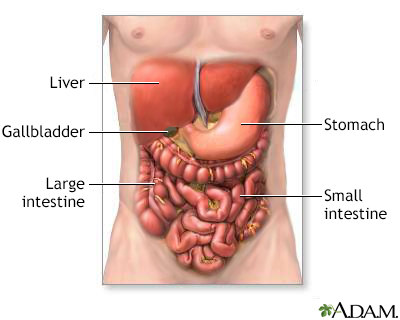Dubin-Johnson syndrome
Dubin-Johnson syndrome (DJS) is a disorder passed down through families (inherited). In this condition, you may have mild jaundice throughout life.

The digestive system organs in the abdominal cavity include the liver, gallbladder, stomach, small intestine and large intestine.
Causes
DJS is a very rare genetic disorder. In order to inherit the condition, a child must get a copy of the variant gene from both parents.
The syndrome interferes with the body's ability to move bilirubin through the liver into the bile. When the liver and spleen break down worn out red blood cells, bilirubin is produced. Bilirubin normally moves into the bile, which is produced by the liver. It then flows into the bile ducts, is stored in the gallbladder, and then flows into the digestive system.
When bilirubin is not properly transported into the bile, it builds up in the bloodstream. This causes the skin and the whites of the eyes to turn yellow. This is called jaundice. Severely high levels of bilirubin can damage the brain and other organs.
People with DJS have lifelong mild jaundice that may be made worse by:
- Alcohol
- Birth control pills
- Environmental factors that affect the liver
- Infection
- Pregnancy
- Fasting or dehydration
- Fatigue
Symptoms
Mild jaundice, which may not appear until puberty or adulthood, is most often the only symptom of DJS.
Exams and Tests
The following tests can help diagnose this syndrome:
- Liver biopsy
- Liver enzyme levels (blood test)
- Serum bilirubin
- Urinary coproporphyrin levels, including coproporphyrin I level
Treatment
No specific treatment is required.
Outlook (Prognosis)
The outlook is very positive. DJS generally does not shorten a person's lifespan.
Possible Complications
Complications are unusual, but may include the following:
- Abdominal pain
- Severe jaundice
When to Contact a Medical Professional
Contact your health care provider if any of the following occurs:
- Jaundice is severe
- Jaundice gets worse over time
- You also have abdominal pain or other symptoms (which may be a sign that another disorder is causing the jaundice)
Prevention
If you have a family history of DJS, genetic counseling may be helpful if you plan to have children.
References
Korenblat KM, Berk PD. Approach to the patient with jaundice or abnormal liver tests. In: Goldman L, Cooney KA, eds. Goldman-Cecil Medicine. 27th ed. Philadelphia, PA: Elsevier; 2024:chap 133.
Lidofsky SD. Jaundice. In: Feldman M, Friedman LS, Brandt LJ, eds. Sleisenger and Fordtran's Gastrointestinal and Liver Disease. 11th ed. Philadelphia, PA: Elsevier; 2021:chap 21.
Roy-Chowdhury J, Roy-Chowdhury N. Bilirubin metabolism and its disorders. In: Sanyal AJ, Terrault N, eds. Zakim and Boyer's Hepatology: A Textbook of Liver Disease. 7th ed. Philadelphia, PA: Elsevier; 2018:chap 58.
Version Info
Last reviewed on: 7/15/2024
Reviewed by: Frank D. Brodkey, MD, FCCM, Associate Professor, Section of Pulmonary and Critical Care Medicine, University of Wisconsin School of Medicine and Public Health, Madison, WI. Also reviewed by David C. Dugdale, MD, Medical Director, Brenda Conaway, Editorial Director, and the A.D.A.M. Editorial team.
